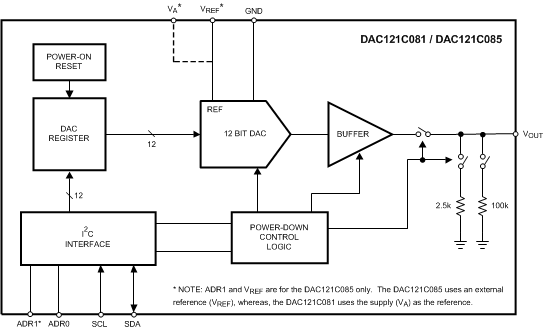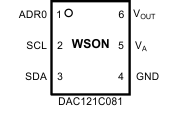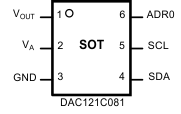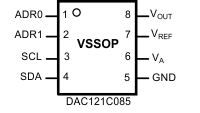-
DAC121C081およびDAC121C085 12ビットMicro Power D/Aコンバータ、I2C互換インターフェイス搭載 JAJSAQ5F December 2007 – October 2016 DAC121C081 , DAC121C085
PRODUCTION DATA.
-
DAC121C081およびDAC121C085 12ビットMicro Power D/Aコンバータ、I2C互換インターフェイス搭載
- 1 特長
- 2 アプリケーション
- 3 概要
- 4 改訂履歴
- 5 概要(続き)
- 6 Pin Configuration and Functions
- 7 Specifications
- 8 Detailed Description
- 9 Application and Implementation
- 10Power Supply Recommendations
- 11Layout
- 12デバイスおよびドキュメントのサポート
- 13メカニカル、パッケージ、および注文情報
- 重要なお知らせ
DAC121C081およびDAC121C085 12ビットMicro Power D/Aコンバータ、I2C互換インターフェイス搭載
1 特長
- 12ビットの単調性を保証
- 低消費電力の動作: 3.3Vで最大値156µA
- 拡張電源電圧範囲: 2.7V~5.5V
- I2C互換の2線式インターフェイス、Standard (100kHz)、Fast (400kHz)、High-Speed (3.4MHz)モードをサポート
- レール・ツー・レール電圧出力
- 非常に小型のパッケージ
- 分解能: 12ビット
- INL: ±8LSB (最大値)
- DNL: 0.6/–0.5LSB (最大値)
- セトリング時間: 8.5µs (最大値)
- ゼロコード誤差: 10mV (最大値)
- フルスケール誤差: -0.7%FS (最大値)
- 供給電力
- 通常: 380µW (3V) / 730µW (5V) (標準値)
- パワーダウン時: 0.5µW (3V) / 0.9µW (5V) (標準値)
2 アプリケーション
- 産業用プロセス制御
- 携帯測定機器
- デジタル・ゲインおよびオフセットの調整
- プログラム可能な電圧源および電流源
- 試験用機器
3 概要
DAC121C081は12ビット、シングル・チャネル、電圧出力のD/Aコンバータ(DAC)で、2.7V~5.5Vの電源で動作します。出力アンプではレール・ツー・レールの出力が可能で、セトリング時間は8.5µsです。DAC121C081は電源電圧を基準として使い、最も広い動的出力範囲を提供します。5Vでの動作時、消費電流は通常値で132µAです。6ピンのSOTおよびWSONパッケージで供給され、3つのアドレス・オプションをピンにより選択できます。
代替品として、DAC121C085は9つのI2Cアドレシング・オプションがあり、外部基準電圧を使用します。性能やセトリング時間はDAC121C081と同じで、8リードのVSSOPで供給されます。
製品情報(1)
| 型番 | パッケージ | 本体サイズ(公称) |
|---|---|---|
| DAC121C081 | WSON (6) | 2.20mm×2.50mm |
| SOT (6) | 1.60mm×2.90mm | |
| DAC121C085 | VSSOP (8) | 3.00mm×3.00mm |
- 提供されているすべてのパッケージについては、データシートの末尾にある注文情報を参照してください。
ブロック図

4 改訂履歴
Changes from E Revision (January 2016) to F Revision
Changes from D Revision (March 2013) to E Revision
- 「ESD定格」表、「機能説明」セクション、「デバイスの機能モード」セクション、「アプリケーションと実装」セクション、「電源に関する推奨事項」セクション、「レイアウト」セクション、「デバイスおよびドキュメントのサポート」セクション、「メカニカル、パッケージ、および注文情報」セクションを追加Go
- Added addresses that the DAC responds to on the I2C bus. Go
Changes from C Revision (March 2013) to D Revision
- Changed layout of National Semiconductor Data Sheet to TI formatGo
5 概要(続き)
DAC121C081およびDAC121C085で使用する2線式のI2C互換シリアル・インターフェイスは、High-Speedモード(3.4MHz)も含む3つの速度モードすべてで動作します。外部アドレス選択ピンにより、2線式バスごとに3つまでのDAC121C081、または9つまでのDAC121C085デバイスを使用できます。DAC121C081には、追加のアドレス・オプションを使用できるピン互換の代替品もあります。
DAC121C081およびDAC121C085には16ビットのレジスタが内蔵されており、動作モード、パワーダウン条件、出力電圧を制御できます。パワー・オン・リセット回路により、0VまでのDAC出力電力が保証されます。パワーダウン機能により、消費電力は1マイクロワット未満まで減少します。低消費電力と小型のパッケージから、これらのDACはバッテリ駆動の機器で使用するための非常に優れた選択肢です。各DACは、拡張産業用温度範囲の-40℃~+125℃で動作します。
DAC121C081およびDAC121C085は、どちらもピン互換なDACファミリの一部であり、このファミリには分解能が8および10ビットの製品も含まれています。8ビットDACについては、DAC081C081とDAC081C085を参照してください。10ビットDACについては、DAC101C081とDAC101C085を参照してください。
6 Pin Configuration and Functions



Pin Functions
| PIN | TYPE | DESCRIPTION | EQUIVALENT CIRCUIT | |||
|---|---|---|---|---|---|---|
| NAME | WSON | SOT | VSSOP | |||
| ADR0 | 1 | 6 | 1 | Digital Input, three levels |
Tri-state Address Selection Input. Sets the two Least Significant Bits (A1 and A0) of the 7-bit slave address. (see Table 1) |
 |
| ADR1 | — | — | 2 | Digital Input, three levels |
Tri-state Address Selection Input. Sets Bits A6 and A3 of the 7-bit slave address. (see Table 1) | |
| GND | 4 | 3 | 5 | Ground | Ground for all on-chip circuitry | — |
| SCL | 2 | 5 | 3 | Digital Input | Serial Clock Input. SCL is used together with SDA to control the transfer of data in and out of the device. |
 |
| SDA | 3 | 4 | 4 | Digital Input/Output |
Serial Data bi-directional connection. Data is clocked into or out of the internal 16-bit register relative to the clock edges of SCL. This is an open-drain data line that must be pulled to the supply (VA) by an external pullup resistor. | |
| VOUT | 6 | 1 | 8 | Analog Output | Analog Output Voltage | — |
| VA | 5 | 2 | 6 | Supply | Power supply input. For the SOT and WSON versions, this supply is used as the reference. Must be decoupled to GND. | — |
| VREF | — | — | 7 | Supply | Unbufferred reference voltage. For the VSSOP, this supply is used as the reference. VREF must be free of noise and decoupled to GND. | — |
| PAD | (LLP only) | — | — | Ground | Exposed die attach pad can be connected to ground or left floating. Soldering the pad to the PCB offers optimal thermal performance and enhances package self-alignment during reflow. | — |